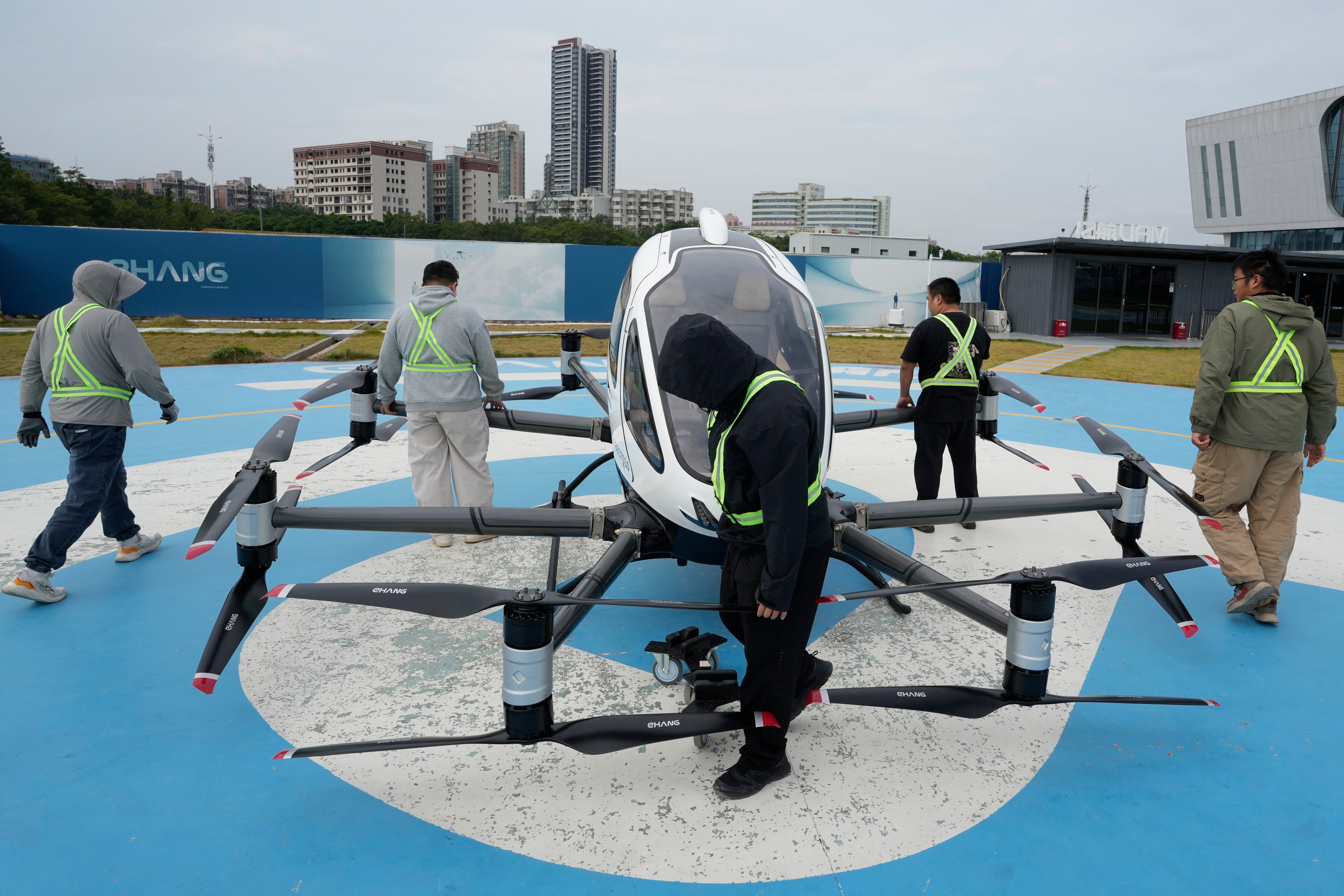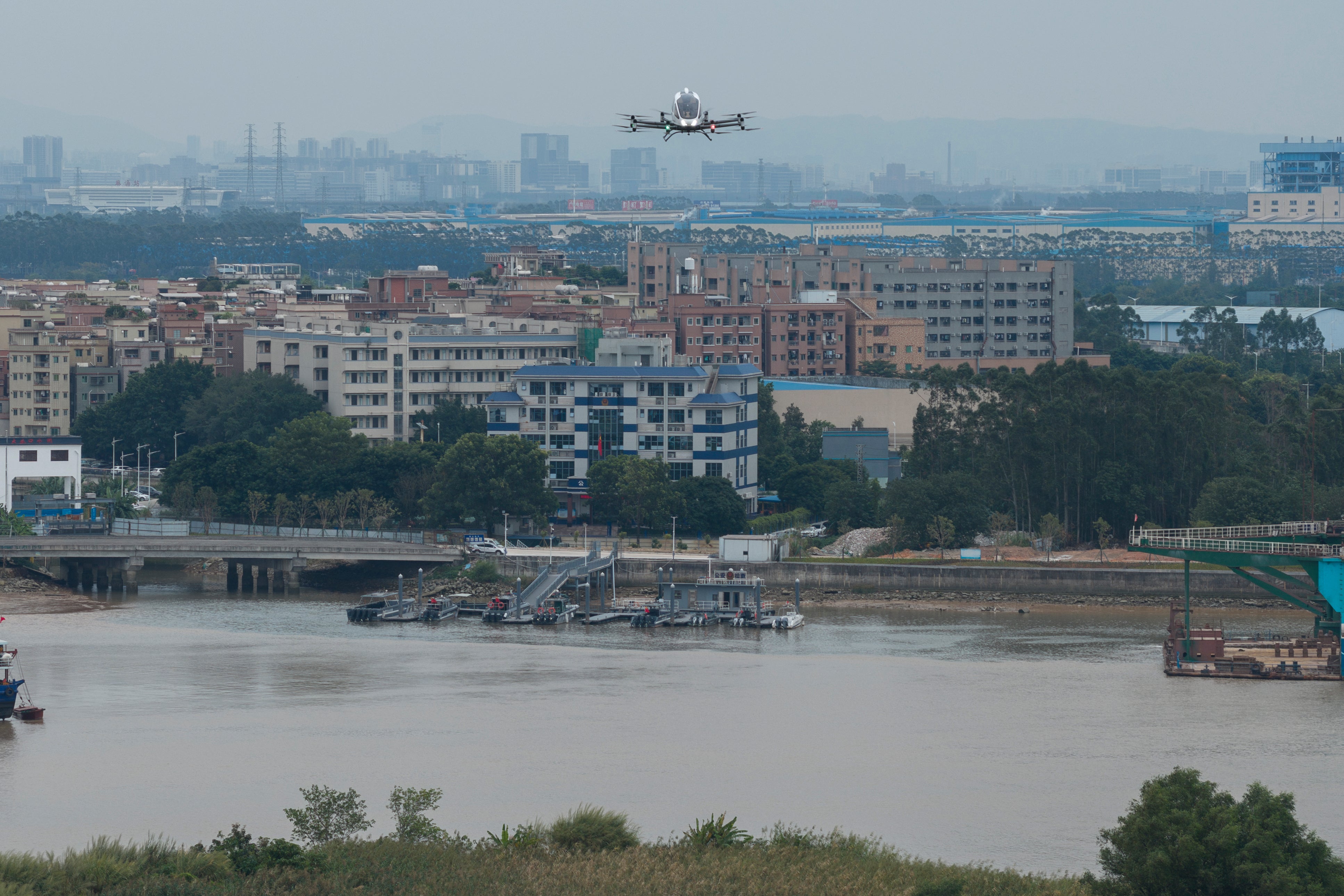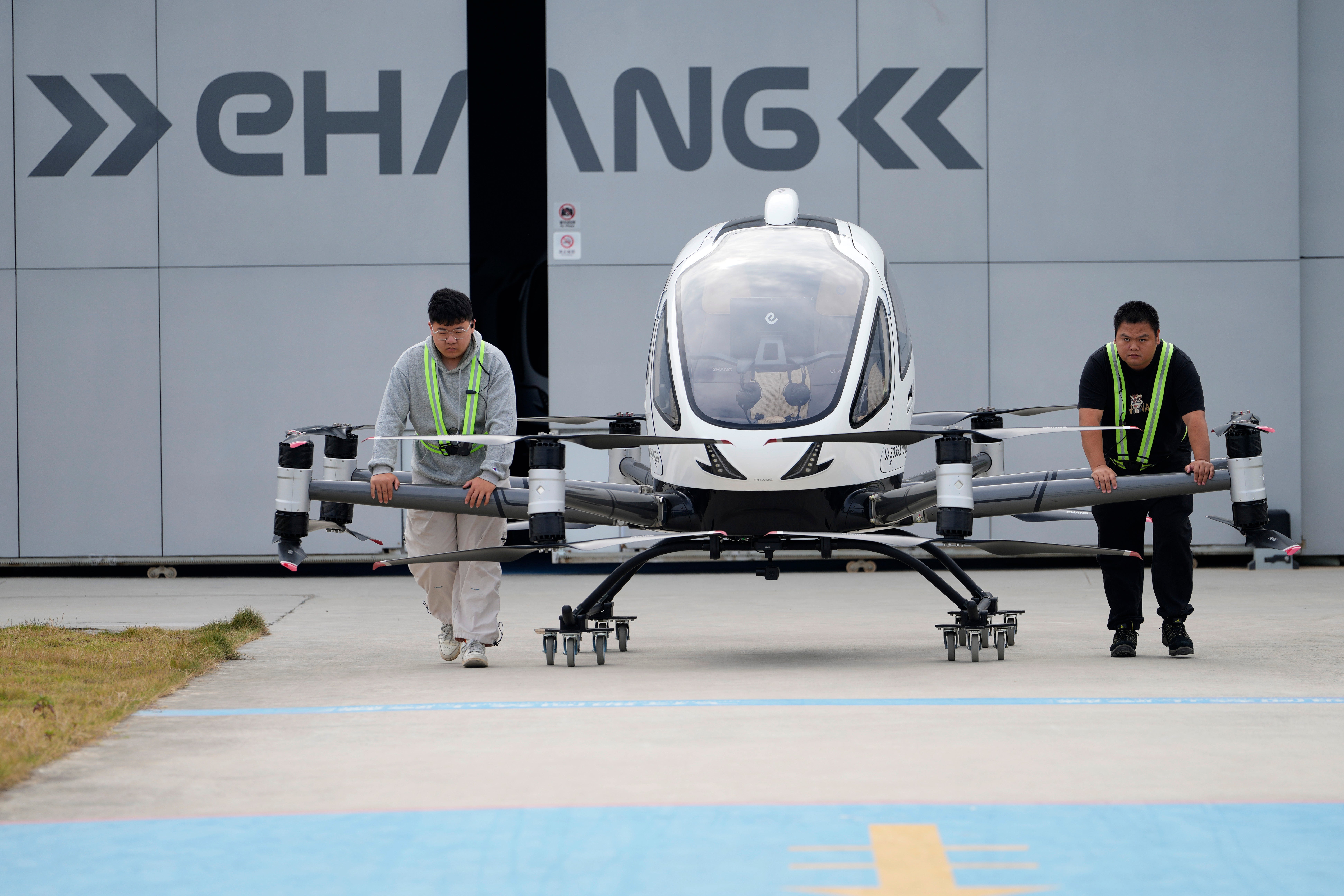- Asia
- China
Chinese companies are rushing to deploy low-flying vehicles and drones for various uses
Kanis LeungMonday 24 November 2025 11:40 GMTComments open image in galleryActivities in airspace below 1,000 meters (about 3,280 feet) accounted for business turnover worth 506 billion yuan ($70 billion) in 2023, about 0.4 per cent of China’s economy (Associated Press)
open image in galleryActivities in airspace below 1,000 meters (about 3,280 feet) accounted for business turnover worth 506 billion yuan ($70 billion) in 2023, about 0.4 per cent of China’s economy (Associated Press)
On The Ground newsletter: Get a weekly dispatch from our international correspondents
Get a weekly dispatch from our international correspondents
Get a weekly international news dispatch
 Email*SIGN UP
Email*SIGN UPI would like to be emailed about offers, events and updates from The Independent. Read our Privacy notice
China's skies are increasingly becoming a testing ground for futuristic transport, with an unmanned, oval-shaped craft from flying taxi maker EHang now undergoing trials in Guangzhou.
The vehicle, described as whirring noisily like a mini-helicopter, evokes scenes once confined to science fiction films, as it hovers over a riverside innovation zone.
This development is part of a burgeoning "low-altitude economy" that is already impacting daily life in nearby Shenzhen.
Here, food-delivery drones are a common sight and a novel attraction for tourists. Polish visitor Karolina Trzciańska experienced this firsthand, ordering bubble tea and lemon tea via drone.
"This is the first time I’m seeing something like this, so it was super fun to see the food being delivered by the drone," she remarked after her drinks arrived through the drizzle.
Such ventures are expanding rapidly with significant government backing, though the sector faces hurdles including stringent airspace controls and battery limitations.
In 2023, activities within airspace below 1,000 metres generated a business turnover of 506 billion yuan (£55 billion), representing 0.4 per cent of China’s economy.
This figure is projected to soar to 3.5 trillion yuan (£380 billion) by 2035, according to Zhang Xiaolan, a researcher at the State Information Center.
Flying cars are in the making
 open image in galleryFood-delivery drones are a common sight and a novel attraction for tourists (Associated Press)
open image in galleryFood-delivery drones are a common sight and a novel attraction for tourists (Associated Press)Guangdong province, home to drone giant DJI with an estimated 70 per cent of the global commercial drone market, leads in development of the low-altitude economy, followed by wealthy eastern coastal provinces Jiangsu and Zhejiang, near Shanghai, according to a report by a research unit of the Chinese Academy of Sciences, Peking University, and other institutions.
Other big players in Guangdong include EHang, logistics company SF Express’s drone arm Phoenix Wings, and automaker XPENG’s flying car unit ARIDGE.
In October, Guangdong announced it plans to speed up construction of flight service stations and platforms to facilitate airspace operations and will support locally issued discount vouchers for low-altitude tourism.
Its technology and financial hub Shenzhen has launched a 15-million-yuan ($2.1 million) award for companies that earn certifications required for passenger eVTOLs, short for “electric vertical take-off and landing" vehicles that lift off the ground like helicopters, among other incentives.
China’s Civil Aviation Administration has granted certificates allowing EHang to offer commercial passenger services with its pilotless eVTOL, a low-altitude aircraft that can reach speeds of 130 kph (81 mph) with a maximum range of 30 kilometers (19 miles).
EHang hasn’t launched commercial routes, but its vice president, He Tianxing, says it aims to start with aerial sightseeing services.
The company has been building takeoff and landing sites in 20 Chinese cities over the past two years. He expects aircraft of various companies will be flying multiple routes, possibly after five years.
He envisions eventual citywide networks using the rooftops of malls, schools and parks as terminals.
“It can’t just be a research product, nor an engineer’s toy,” he said.
Accidents, battery limitations and airspace controls
 open image in galleryActivities in airspace below 1,000 meters (about 3,280 feet) accounted for business turnover worth 506 billion yuan ($70 billion) in 2023, about 0.4 per cent of China’s economy (Associated Press)
open image in galleryActivities in airspace below 1,000 meters (about 3,280 feet) accounted for business turnover worth 506 billion yuan ($70 billion) in 2023, about 0.4 per cent of China’s economy (Associated Press)The biggest challenge for developing eVTOL aircraft is maintaining longer flights and overcoming battery capacity limitations, said Guo Liming, co-founder of Shenzhen-based Skyevtol, whose single-seat manned eVTOL aircraft, priced at around $100,000, can only fly 20 to 30 minutes before it must be charged.
It also has not all been smooth skies.
In September, two XPENG's eVTOL aircraft collided after a rehearsal for an exhibition and one of them caught fire while landing. The company said no one was hurt, but another expo canceled flying demonstrations a week later.
Undeterred, XPENG has continued to showcase its flying cars, including a six-wheeled ground vehicle with a detachable eVTOL aircraft. Having invested over $600 million, the company said it has more than 7,000 global orders for its “Land Aircraft Carrier” and has begun preparing for mass production.
A trial run of sightseeing flights in Dunhuang, a key ancient Silk Road destination famous for its Buddhist caves and dunes, is planned for next July.
It's unclear how quickly such aircraft might begin carrying paid passengers regularly. Some companies elsewhere have burned through their funding before reaching the commercial launch stage.
 open image in galleryThe biggest challenge for developing eVTOL aircraft is maintaining longer flights and overcoming battery capacity limitations, said Guo Liming, co-founder of Shenzhen-based Skyevtol (Associated Press)
open image in galleryThe biggest challenge for developing eVTOL aircraft is maintaining longer flights and overcoming battery capacity limitations, said Guo Liming, co-founder of Shenzhen-based Skyevtol (Associated Press)In Germany, air taxi makers Lilium and Volocopter filed for bankruptcy, though the latter was later bought by Diamond Aircraft Group, a subsidiary of a Chinese firm.
After years of commercialisation, drone applications are not that widespread in China.
Even though the country leads in drone technology and manufacturing, policy constraints including limited airspace access, may mean overseas markets are more promising, said Frank Zhou, managing director at GBA Low Altitude Technology Co., which provides technological software to clients.
“Perhaps for some Southeast Asian countries, if I introduce these applications to them, their demand could explode,” he said.
Less than one-third of China's low-altitude airspace was accessible for general aviation use in 2023 and there were problems with uneven distribution and a lack of internet connectivity, Zhang, the State Information Center researcher, said in a report. The number of registered general aviation aerodromes in China, excluding private airports, was just about a tenth of those in the US, she said.
Officials are easing their grip, but there’s turbulence ahead
 open image in galleryChina is a latecomer to the industry but now leads in developing small drones and low-altitude airspace investments (Associated Press)
open image in galleryChina is a latecomer to the industry but now leads in developing small drones and low-altitude airspace investments (Associated Press)Chinese policymakers are gradually working to close the gap. The military generally commands use of most Chinese airspace but has pledged to simplify approval procedures and shorten review times in Shenzhen and five other provinces.
Proposed revisions of the civil aviation law include a chapter on development and promotion of civilian activities, addressing low-altitude airspace allocation and supervision.
It's still early days, said Gary Ng, a senior economist at Natixis Corporate and Investment Banking.
He expects progress toward commercialisation to materialise around 2030, with passenger-carrying eVTOLs for tourism or industrial purposes starting before flying taxi services. Some of the aerial products could become key exports, he said.
China is a latecomer to the industry but now leads in developing small drones and low-altitude airspace investments, said Chen Wen-hua, director at the Hong Kong Polytechnic University’s Research Centre for Low Altitude Economy.
One advantage is the ruling Communist Party's ability to mobilise regulators, industry players and universities to work toward the same goal, he said. But development of the technologies involved and safety concerns and public acceptance will determine how quickly different applications of drones and low-flying vehicles are adopted.
The future for the low altitude economy is bright, Chen said, “however, the road leading to that bright future might be treacherous.”
More about
GuangzhouShanghaiBeijingJoin our commenting forum
Join thought-provoking conversations, follow other Independent readers and see their replies
Comments


